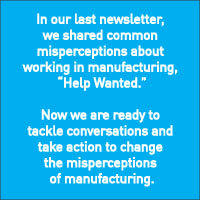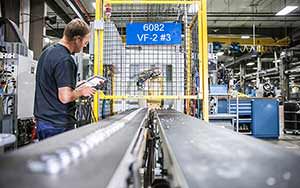At our exhibit at the Minnesota State High School Trapshooting Tournament, I was showing a student’s father some items we make, while also discussing the opportunities that exist around manufacturing careers. Out the corner of my eye, I noticed the student’s mother stick a finger down her throat as if she would gag at the thought of anyone working in manufacturing.
This gesture stunned me. Because I know firsthand of great careers available in manufacturing. Her impression, however disappointing, is all too common.
While it is clear to manufacturers that advancements in technology have revolutionized our work, we all need to find a way to get through to those important to our success, especially those who are not even willing to listen.
So what can you do to change the misperceptions about working in manufacturing? Where should you start?
The effort may seem daunting, but to change the misperceptions, you can educate those you want to influence about what it is truly like to work in manufacturing TODAY. One conversation at a time, you can:
- Share detailed information about the different roles and skill sets needed in manufacturing
- Show your career opportunities, the education path, and ways to get started
- Share facts about manufacturing – industry statistics, growth potential, jobs, career paths, wages, and benefits offered
All of your efforts will help close the skills gap and ensure the future of U.S. manufacturing remains strong and continues to grow.
Step 1: BUILD Relationships
The first step to change misperceptions about working in manufacturing is by forming relationships with the people you want to educate – those who are important to your success.
- Students
- Parents and grandparents
- Teachers
- School counselors
- Academic advisors
Build relationships with students by meeting and getting involved with them on their turf.
- Support academic advisory committees: Participate in academic advisory committees to set course curriculum and expose students to advanced technologies used in manufacturing.
- Connect with students: Work with high schools and technical college students, providing projects, and bringing subject matter expertise and manufacturing solutions to their coursework.
- Volunteer for Jr. Achievement: Meet with elementary students to build relationships and spark their interest in manufacturing a young, impressionable age.
- Visit classrooms: Talk about manufacturing. Share things you make, and showing them images of your work environment. Spark their interest in wanting to how to make things.
- Support student programs: Work with high school robotics teams to provide engineering design assistance, financial support, and fabricated components to build their robots.
- Seek students where they gather: Exhibit at student events, such as the state high school trapshooting tournament, where 30,000 student competitors, and their parents, gather.
- Connect with non-traditional students: Reach out to local homeschooling communities or online students – an untapped audience.
- Educate influencers: Meet with guidance counselors and academic advisors. Invite them to your organization, share industry facts and details about manufacturing careers. Emphasis that there needs to be a change in mindset that every student should pursue a four-year college track.
In every conversation with students, share information that is easy for them to understand. Talk about how they will work with their hands and build things. Tell them they could be the one to create a revolutionary medical product doctors would use to save lives. Share unique stories, such as this EdgeFactor video, to show how a life-changing event can lead to a medical breakthrough.
Step 2: PARTNER with Industry
Work with industry organizations that serve manufacturers to communicate your messages to the people you want to reach. Many state and national organizations are participating in specialized efforts to change the misperceptions many people have.
What organizations can you partner with?
Here is a sampling national, regional and state organizations working to share the message about great manufacturing careers.
- Manufacturing Institute (National)
- National Association of Manufacturers (National)
- Society of Human Resources Management (National)
- Society of Manufacturing Engineers (National)
- Tri-State Manufacturers’ Association (Regional)
- Enterprise Minnesota (State)
With a myriad of organizations, manufacturers can work together to educate others and change the image of manufacturing.
Step 3: CHANGE the Image
 Those who you want to educate about the reality of today’s manufacturing careers, may still visualize work in manufacturing as it was during the industrial revolution. We need to show people the transformations that have taken place. Until the dirty, assembly line, black and white visual representation of yesteryear changes, people may be reluctant to believe in the value of manufacturing careers.
Those who you want to educate about the reality of today’s manufacturing careers, may still visualize work in manufacturing as it was during the industrial revolution. We need to show people the transformations that have taken place. Until the dirty, assembly line, black and white visual representation of yesteryear changes, people may be reluctant to believe in the value of manufacturing careers.
What can you do to help change the visual representation of manufacturing?
- Make sure your manufacturing images (photos, videos, websites, stories, etc.) and onsite tours feature the latest manufacturing technologies, such as robotics and automation equipment.
- Show a safe work environment in all of your communications and marketing materials.
- Feature happy employees in clean uniforms, brightly lit facilities and colorful environments.
- Host a tour. Show them what you make and your high-tech equipment to give people a realistic view of today’s manufacturing.
Step 4: TARGET Others
Sharing the great news about career opportunities in manufacturing with other groups can be just as important to our growth and success.
- Veterans looking for a good job often have a technical background and can be an ideal fit for manufacturing.
- Stay-at-home-parents, ready to find employment outside the home are another good prospective group. These people may have been out of the workforce for 5, 10 or 20 years, with no real understanding or knowledge of all the great changes happening in manufacturing.
- Individuals seeking a career change, mid-life, may welcome the opportunity to work with their hands and learn how to make things. They may have never considered what manufacturing careers have to offer.
What can you do to reach other populations?
- Connect with your local veteran’s office to develop a relationship with them and discuss ways you would like to reach veterans to share the good news about manufacturing career opportunities. Work with them to create a “Veteran’s Tour of Manufacturing.” Partner with other local manufacturers to host a city-wide, day-long Veteran’s Tour. Host informational sessions at each company to share detailed information and current career opportunities.
- During tours, show veterans what each company makes and the different technologies they use. Introduce them to your employees and ask employees to share their professional history and what they do at work, specifically.
Step 5: SHARE Best Practices
Changing the manufacturing’s misperceptions is not about recreating the wheel. It is about keeping the effort alive, fresh and productive.
Go crazy. Get creative. Develop a video game that features a high-tech manufacturing environment maze with different levels to get through one-step at a time. Host a high school design contest, asking students to compete to build a better mousetrap.
Commit to developing and sharing the ways you are changing manufacturing’s misperceptions. The opportunities to share today’s manufacturing message and the abundance of jobs are virtually endless.
What will you do next?
Start today! Take on the challenge. Work with other manufacturers and the organizations that support these efforts. One conversation at a time, change what people believe about working in manufacturing and the shortage of skilled workers will no longer be a concern.
Share best practices. Do not worry about competitors stealing your great ideas. With 2 million job openings going unfilled over the next decade, if we do not find a way to attract employees, we will not have the jobs to fill. Period.
What will you do to make the change happen? Let us know. Email your efforts and ideas to phoffman@alexandriaindustries.com. We will keep a list and share these in future newsletters.
